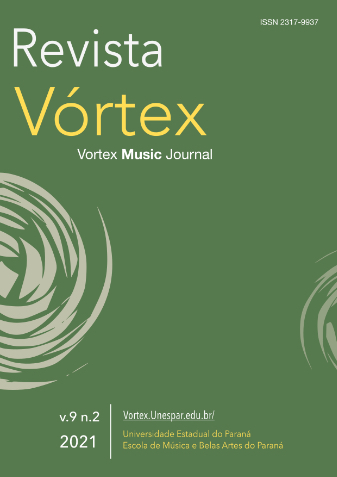Pandemics, Delays, and Pure Data: on 'afterlives' (2020), for Flute and Live Electronics and Visuals
DOI:
https://doi.org/10.33871/23179937.2021.9.2.17Palabras clave:
Pure Data, time warping, phase vocoder, live electronics, multimedia compositionResumen
The essay addresses creative and technical aspects of the piece 'afterlives' (2020), for flute and live electronics and visuals. Composed and premiered in the context of the COVID-19 pandemic, the composition employs audiovisual processes based on different audiovisual techniques: phase-vocoders, buffer-based granulations, Ambisonics spatialization, and variable delay of video streams. The resulting sounds and images allude to typical situations of social interaction via video conferencing applications. 'Afterlives' relies on an interplay between current, almost-current, and past moments of the audiovisual streams, which dephase the performer's images and sounds. I have avoided, in text, delving deeper into the Pure Data abstractions and or into the musical analysis of my composition. The main purpose of the text is rather to present compositional/technical elements of 'afterlives' and discuss how they enable new experiences of time.
Descargas
Citas
BERGSON, Henri. Matière et mémoire: essais sur la relation du corps à l'ésprit. Paris: Presses universitaires de France, 1985.
DELALANDE, François. Le son des musiques: entre technologie et esthétique. Paris: Institut national de l'audiovisuel : Buchet/Chastel, 2001.
DOSI, Giovanni. Technological paradigms and technological trajectories: A suggested interpretation of the determinants and directions of technical change. Research Policy, v. 11, n. 3, p. 147–162, 1 jun. 1982.
EMMERSON, Simon. Living electronic music. Burlington: Ashgate, 2007.
FERRAZ, Silvio. Time Music between Lines and Images: Time In-between. In: ASSIS, P. DE; GIUDICI, P. (Org.). . Machinic Assemblages of Desire: Deleuze and Artistic Research 3. Leuven University Press, 2021. .
KUHN, Thomas S. The structure of scientific revolutions. 3rd ed ed. Chicago, IL: University of Chicago Press, 1996.
LEROI-GOURHAN, André. Evolução e Técnicas: 1 - O Homem e a Matéria. Translated by Fernanda P. Basto. Edições 70 ed. Lisboa, 1984.
MUSIL, Thomas; NOISTERNIG, Markus; HÖLDRICH, Robert. A library for realtime 3d binaural sound reproduction in pure data (pd). 2005, 2005.
SÈDES, Anne; GUILLOT, Pierre; PARIS, Eliott. The HOA library, review and prospects. 2014, 2014. p. 855–860.
SIMONDON, Gilbert. Du mode d'existence des objets techniques. Paris: Aubier, 1989.
Descargas
Publicado
Cómo citar
Número
Sección
Licencia
Derechos de autor 2021 José Henrique Padovani

Esta obra está bajo una licencia internacional Creative Commons Atribución 4.0.
Los autores conservan los derechos de autor y conceden a la revista el derecho de primera publicación, con el trabajo simultáneamente bajo la licencia Creative Commons Attribution Licence que permite compartir el trabajo con reconocimiento de autoría y publicación inicial en esta revista.






